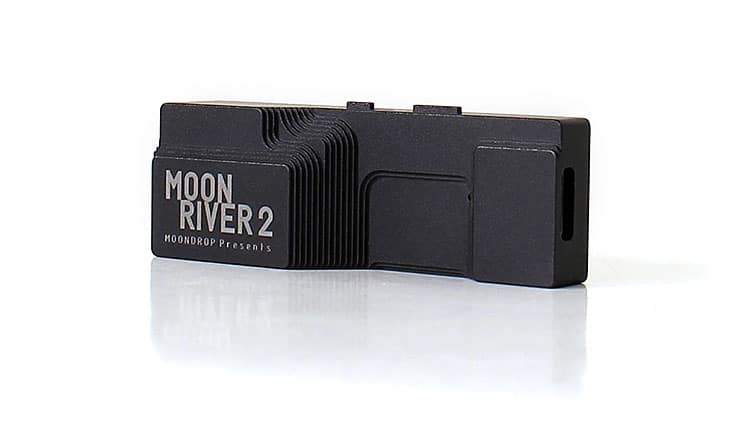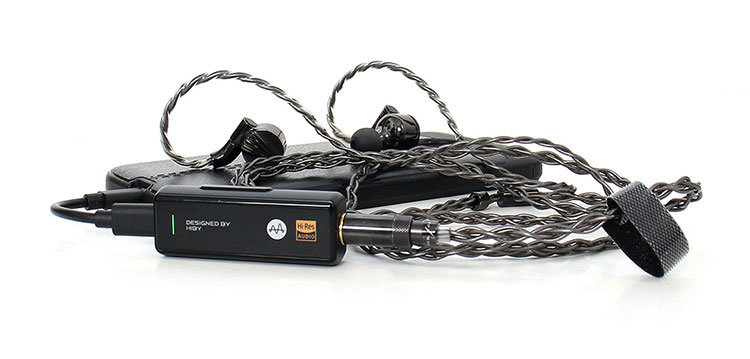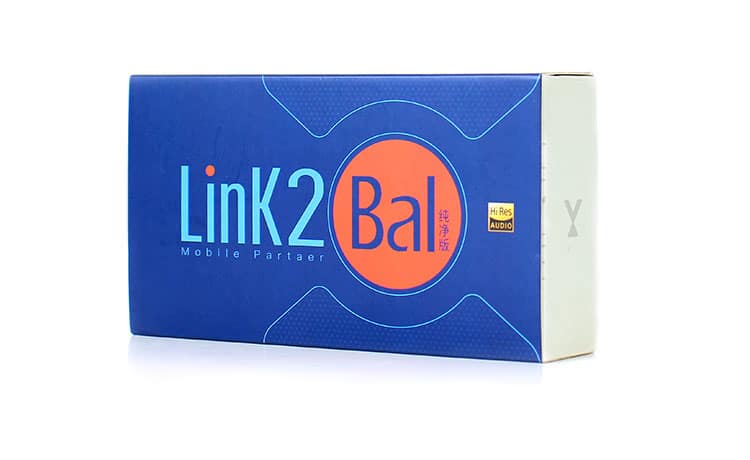Select Comparisons
Moondrop MoonRiver 2
Price $189.99
Technical
Although the MoonRiver 2 uses a similar DAC chip implementation it upscales over to a dual CS43198 setup that ensures a rock-solid digital conversion which will most definitely play friendly with most of today’s digital formats.
The Moondrop MoonRiver 2 can run PCM at up to 32-bit and 768kHz plus DSD256, however, there’s no MQA similar to the xDuoo Link2 Bal. But with slightly higher rates on PCM, it seems it takes a lead in this particular area.
Design
The MoonRiver 2 certainly has an oddball shell design that has what looks like irrigation channels or some sort of a simulated ancient alien step construction ruin, on the moon perhaps. Get it? The shell is composed of two pieces, CNC shaped, and with a single set screw to hold the two pieces together.
The shell is made of aluminum with an all-around dark grey anodized finish. One side displays a diagram of the circuitry but I would have much preferred a clear window to see the actual internal components similar to the Questyle M15.
The MoonRiver 2 shell does have a few sharp corners but the half-slimmed-down shape seems a bit lighter in weight compared to the Link2 Bal. The overall dimensions are similar but I do prefer the rounded corner design.
Performance
Again, both these dongles display a calm nature that tries to steer away from sounding too harsh or unnatural and too forward. Bass production is generous on both dongles but there seems to be a mid-forward or focused aspect more so here with a high-frequency section that always remains under the pain threshold.
Both display warmth in the lower region the same but the MoonRiver 2 pushes in a forward position due to the higher voltage output rating of 4V. Where I sense a difference between the two is within the overall soundstage more than with its tonality since they both use similar DACs that are made by the same manufacturer.
The Link2 Bal is the wider sounding and the height in particular seems better portrayed. It gives the listener just enough of a wide space which doesn’t affect the overall impactfulness and presence. The MoonRiver 2 seems more focused and centered.
The darker of the two is the MoonRiver 2 and possibly dynamic range is portrayed better on it also. But the main selling point is the improvements in staging the MoonRiver 2 brought to the table at a time when most dongles were sounding rather narrow and center-focused.
HiBy FC5
Price $159.00
Technical
The HiBy FC5’s most prominent niche point is a more upscale and sophisticated DAC chip with a clean output. The FC5 uses a dual ES9281PRO setup with an additional pair of ES9603 amplifier chips to feed the single 4.4mm output connection.
The FC5 DAC section can do MQA, unlike the Link2 Bal which sticks to the more traditional PCM and DSD formats. Both dongles handle 32bit at up to 384kHz rates but the FC5 only reaches DSD128 while the Link2 Bal can reach DSD256 levels of decoding.
Design
These two models feel the same in your hands since they both have a similar construction scheme and are similarly shaped.
However, the FC5 only has a single 4.4mm connector and that might turn off some buyers although the unit comes with a conversion cable that allows you to connect 3.5mm single-ended equipped gear on the FC5 out of the box.
Some might consider this a con but the fact that the FC5 only has a single 4.4mm connection might even be a benefit if you plan on using the 4.4mm connection exclusively. On other dongles, there’s always going to be an extra orifice there that will expose the unit to dust bunnies and rain.
Performance
The HiBy FC5 is big on clarity but not on power output making it the least capable in this particular area within this comparison. But it does a great job at translating a digital signal into an audible one and it could have the cleaner DAC section of the two.
The FC5 has a very dark character and a noise-free background but it carries a lower 112dB signal-to-noise ratio. It seems the FC5 was tuned to not push the hardware boundaries to its limits and prefers to stay within a comfortable level of performance to maintain purity and not overexert the circuitry.
The overall frequency response and tonality are well balanced but the overall size of the stage was somewhat restricted especially when it comes to height projection. It also portrays an eye-level center stage typical of gear that lacks height.
Where it stands out is with its ability to retrieve details and micro staging is also done on a top-notch level especially compared to yesterday’s models.
iBasso DC06
Price $119.99
Technical
The iBasso DC06 is the most powerful dongle in this lineup and if that’s what you need then this dongle has 320mW on tap available from a set of the same ES9219C Quad DACs they used on their own DC05 dongle DAC.
However, iBasso acquired high power output numbers on the DC06 by beefing up the voltage circuitry to feed the dual DAC circuitry lots of clean operating power while at the same time keeping that power clean which simultaneously reduces noise.
The DAC section within the DC06 is MQA capable plus it can do the same digital format rates of DSD256 and PCM at up to 32bit / 384kHz. So, in this area, the DC06 excels over the others although it’s the ‘economy’ model in this group and comparison.
Design
The DC06 is probably the most robustly constructed dongle DAC in this comparison. The all-metal shell has a fin design similarly found on some older automotive speaker amplifier models. But the fins are all looks since the DC06 doesn’t seem to run hot at all and has no need for heat dissipation.
There are a couple of headphone outputs which are comprised of a 3.5mm single-ended and a 4.4mm balanced connector. The standard USB-C port sits at the bottom and acts as the sole source input connection.
The DC06 however does not have an onboard volume control nor a gain control and mostly relies on an app-based adjustment system which is absent on the Link2 Bal.
The shell itself has no buttons or switches. The only visible object on the DC06 shell is the format indicator LED which was placed right under both headphone output plugs but it’s very small and somewhat inconspicuously placed.
Performance
The warm character of this dongle is subtle because it’s more of a balance between warmth and neutrality. The bass response is most noted since the DC06 has the most power and it seems more capable as far as driving power.
The one area that is most noticeable as far as a sound signature is the larger panorama you perceive with the Link2 Bal. Most super wide-sounding gear can botch up realism and presence but the Link2 Bal keeps a best-of-both-worlds aspect.
The DC06 has very good detail retrieval qualities but there’s a slight underfill within the imaging which is done slightly better on the Link2 Bal plus it portrays a larger panorama that keeps the listener further interested in the listening experience.
Our Verdict
The xDuoo Link2 Bal is a dongle that lacks an app and some of the features that carry a similar price tag but it gives the buyer a good listening experience. Although it’s not the most powerful in output, it has good technical abilities.
It seems now dongle makers have realized that within the size limitation of a dongle, power becomes limited with current tech so they’ve decided to focus on true tone reproduction and most of all, are looking for ways of improving the sound stage and this is what we have here.
As stated, not the most powerful out there but the other fact that it has under its belt is a good ability to bring forth detail and to remain focused and not sound confused or conglomerated. So bottom line, is this xDuoo’s best dongle yet? You bet.
xDuoo Link2 Bal Technical Specifications
- DAC Chip: CS43131 x2
- Input Port: Type C USB
- Output Port: 3.5mm + 4.4mm
- Output Power: 3.5mm / 125mW @32Ω – 4.4mm/ 270mW @32Ω
- Sample Rate Support:
- PCM 16-32bit 44.1-384kHz
- DSD: DSD64-DSD256
- Frequency Response: 20Hz to 20kHz ±5db
- THD: 0.001% 1kHz 3.5mm / 0.0007% 1kHz 4.4mm
- SNR: 123db 3.5mm / 123db 4.4mm
- Crosstalk: 3.5 output ≥77db / 4.4 Output ≥120db
- Weight: 28 grams
- Size: 63mm x 23.5mm x 13mm





